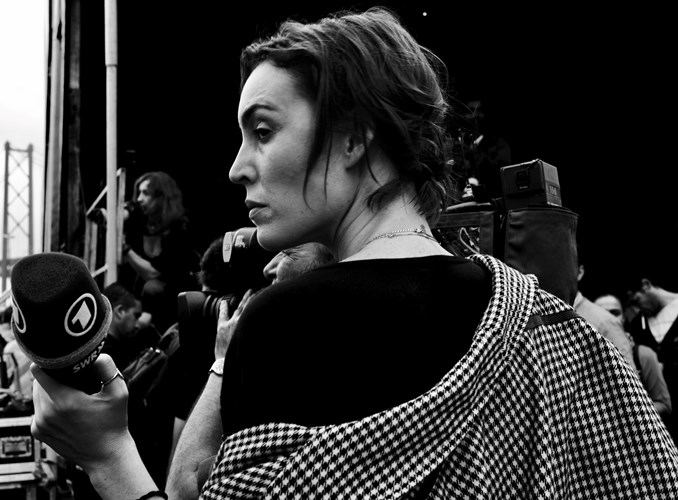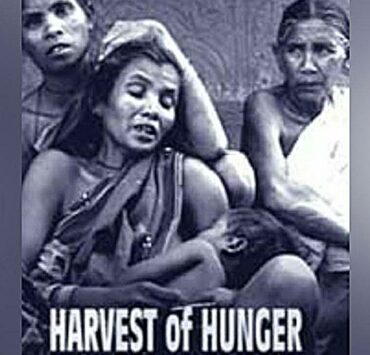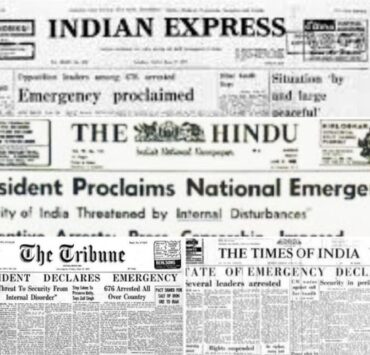
Guest column by Usha Rai

They were given the crumbs from the newspaper table, while senior male colleagues hogged the prime beats
Extracted from Status of Women Journalists in India, produced by the Press Institute of India, under the aegis of the National Commission for Women.
In the sixties there were very few women in daily newspapers (English as well as regional), either on the desk or as reporters. Most papers did not even have a single woman. The few who got entry stood out ‘ fortunately not as sore thumbs’ but as bright eyed, educated young women trying to storm into a male bastion. They were gawked at and there was a lot of speculation as to how long they would survive in the taxing profession. Probably their biggest qualification was that they could write well. They contributed greatly to the feature sections of the newspapers.
Several newspapers had an unwritten law that they would not admit women into what was considered a male domain. They had to struggle to push open doors. A classic example is that of the late Prabha Dutt (nee Bahl) who graduated from the Chandigarh School of Journalism with honours and did her inhouse training with Hindustan Times, Delhi in 1964. When she asked for a job at the end of the training, the editor, Mr Mulgaonkar said the paper did not employ women. Prabha left only after a written assurance from the editor that if he ever employed a woman, she would be considered.
A few months later when he employed a young woman on the desk, who had done her degree in journalism from the US, she barged into his office and got herself a job. A highly competent journalist she rose to become the first woman chief reporter of a national daily.
The only woman in the editorial of the Times of India (TOI) in the midsixties, I was called into the cabin of the editor and told by Mr Girilal Jain that a newspaper was no place for a woman. What provoked him to make such a statement is not clear but he did not repeat the statement. Subsequently his own daughter became a journalist.
There were very few women in newspapers in the early sixties and they were not allowed to do night duty. According to the labour laws, there should be at least two women on a night shift. The office also has to provide transport back home after night duty. So this important shift, which brings out the newspaper, was devoid of women till the mid-seventies. While several news editors and editors used this pretext of the ‘law’ to keep women out of the desk in newspapers, there were a few women, who quoted the law, to avoid the night shift. When the first woman to get on the desk in the Times of India, Delhi, refused to do night duty, sighting labour laws, the management’s back was up against employing women on the desk. Subsequently, this young woman left to join the Indian Administrative Service. It was much later that a gutsy woman called Suchitra Behl opted to do night duty even if there was no other female support on the desk.
Kamla Mankekar, a veteran journalist who worked for the Times of India and the Indian Express in the fifties and sixties, says that the Statesman, Delhi, was one of the first newspapers to employ a fulltime sub editor in the fifties. Raj Chawla, was an extremely competent sub editor who wielded the pen with a flourish that could make or mar a story. However, she did not do night duty and Pran Chopra, the editor of Statesman, used it as the reason for keeping out Razia Ismail when she approached him for a job. ‘You will not do night duty or work late evenings,’ he said and did not give her a chance to prove him wrong.
In the reporting side too there were so few women that no one was asked to do night duty. Coomi Kapoor of the Indian Express recalls that she was one of the first women who volunteered for night duty. This won her immediate acceptance by her male colleagues.
I was the only woman in the editorial section of the TOI, Delhi, for close to eight years from 1964. The other women were working as receptionists and telephone operators. There was no toilet for women in the editorial floor, so I had to go to the ground floor and share the toilet with the telephone operators. Fortunately there was a woman, Maya Sharma, in the Sunday section of Navbharat Times, the sister Hindi publication, with whom I could share problems and exchange confidences.
In 1969 when I was expecting my first child I asked for maternity leave and was told by the personnel department that there was no such provision. When I pointed out that this was my right and not a personal favour, I was allowed to take the leave. Coomi Kapoor recalls that in the old days the three months maternity leave was split – six weeks had to be taken before the birth of the baby and six after. Now there is no such rule and women can come to work till the day the baby is born and take all three months leave after its birth so that they have more time with the baby.
Our study shows that in the regional press there is still reluctance to employ young women in the reproductive age group because they may take maternity leave or because they fear her home will receive greater priority, especially if she has children. So a lot of young women journalists are putting off marriage and if they do marry, postpone having a child. In the old days, when promotion for reporters were few and far between, the upwardly mobility was doubly difficult for women. Coomi recalls that in the long but necessary absence from work because of maternity, her seniority was overlooked and a male was made chief reporter. Vandana Walia Bali of Punjab Kesri too spoke about being denied seniority after maternity leave.
To be taken seriously, women journalists of yesteryears had to look grown up. They wore saris and salwar kameez to work. No one dared to come to work in trousers or skirts. A senior journalist recalls her great dilemma as to whether to clutch her male colleague while riding pillion on a two wheeler from Teez Hazari courts to the office of the Municipal Corporation or just balance as best as she could, lest she provoke gossip. Today, mainstream national newspapers are teeming with women, a lot of them wearing jeans and even skirts.
But the biggest challenge for the early women to get into mainstream newspapers was the kind of work assigned to them. They were literally given the crumbs from the newspaper table. Senior male colleagues hogged the prime beats — political parties, Parliament, Prime Minister’s office, important ministries like Home, Commerce, Finance and Foreign Office. Women were initially asked to cover flower shows, fashion shows, health and education – all considered soft beats. Till the seventies there may have been just one woman in each newspaper and two or three on the news desks in the English national dailies of the Capital. The picture was much bleaker for the regional press. In fact even today you hardly find any women working as special correspondents or even as reporters in the language press in the Capital. It is much worse in other parts of the country. S .H Savitri, executive editor of Kannada magazine Kannaveera, points out it will take at least 20 years for the regional press to match the facilities and opportunities enjoyed by women in the English language press.
From the eighties the scene began to change dramatically. In the English language national newspapers of the Capital, it was as if the floodgates had opened. As women topped in the journalism courses of the country and their writing skills got recognition, they began to storm the male bastion. By mid-eighties, on some days you could see an all woman shift bringing out the early editions of the Delhi Times of India. The appointment of the first women chief sub, actually bringing out the newspaper, was a landmark in the same newspaper. The news editor is one of the most powerful persons on a newspaper and currently the Statesman in New Delhi has Usha Mahadevan as its news editor. Gauri Chatterji was news editor in the Anand Bazar Patrika before moving to the Telegraph as features editor. At the Indian Express, Delhi, TOI -Delhi and Mumbai, Hindustan Times-Lucknow, women are currently resident editors.
In the regional press women are more visible but they are largely on the desk or in the Sunday sections of newspapers. A lot of them write for the supplements. They write about social gossip, party circuits, films and celebrities. There are very few women reporters and special correspondents. However, the regional press bureaus in Delhi do have a few women who do city reporting and even cover Parliament.
The scene in the English national newspaper offices is vastly different. Newspapers are teeming with young women journalists. They are covering economic and business news, politics, the CBI, the foreign office, sports and even the stock market. They are a talented and educated lot and extremely ambitious. There is cut throat competition to get to the top. In the old days there was a lot of bonding among journalists. News from different beats was often shared, but no longer. Today, the more successful male and women journalists are those closest to the management/the newspaper owners. Many young women, like their sisters in the regional press, are writing ‘tittle tattle’ for the glossy, coloured supplements.
In the old days women were secure in their jobs. Most of them were on wage board scales and promotions were few and far between. This is no longer so, in the national or the regional press. Most journalists are on contracts, or worse still, on the voucher system. At the end of the month, like daily wage labour, they sign vouchers and get a pittance that could vary from Rs 1500 to Rs 3000 in the regional press. Contracts, even in the national press, are for two and three years, so you are always at the mercy of the management. There is arm twisting of journalists on wage board scales to compel them to accept the contract system. They are transferred to other states and distant places, even if they have a family at their place of work. In the process many of them opt out of journalism or have to look for jobs elsewhere. In the absence of wage board scales in most newspapers, there is tremendous variation in the earnings of the journalists. While many journalists in senior positions earn between Rs 30,000 to Rs 50,000, others in the regional press are barely able to keep body and soul together on the monthly salary of Rs 1500 to Rs 3000.
In the old days when there were few women in newspapers, there was a tendency to be protective towards them by the national press and the bhadraloks. While this was very ‘nice,’ it did not always work in the professional interest of the journalist. I remember how two of my male colleagues were sent to rescue me when, as an eight months pregnant journalist, I was covering a price rise demonstration outside the Super Bazar in Delhi and there was tear gassing. There was sheer panic in my office till the police control room and the magistrate on duty confirmed I was ‘safe.’ In the Statesman, Delhi, when Tavleen Singh, a bright, independent journalist, insisted that she would drive home in her own car after night duty instead of taking the office car, a chauffeur driven office car was sent as escort behind her. Over protection hampers a woman professionally.
Contact:pii@ndf.vsnl.net.in
Source: http://asu.thehoot.org/media-practice/women-in-journalism-then-and-now-1226




